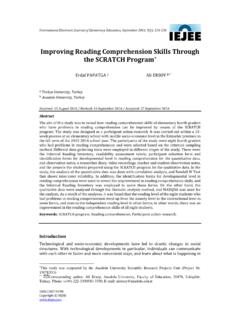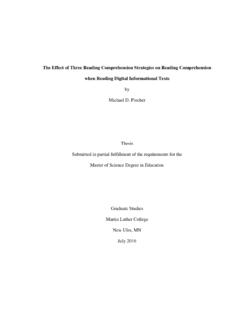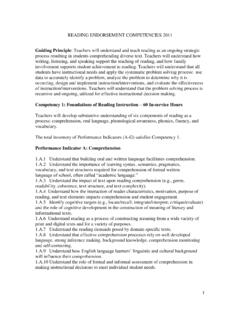Transcription of Improving Reading Fluency and Comprehension Among ...
1 Improving Reading Fluency and Comprehension Among Elementary Students: Evaluation of a School Remedial Reading Program Robin Hausheer, Alana Hansen, and Diana M. Doumas Boise State University2 Abstract This study examined the effectiveness of a remedial Reading program on Improving Reading Fluency and Comprehension Among elementary school students. Twenty-four students were selected to participate in an eight-month program. Results indicated Reading Fluency and Reading Comprehension scores improved significantly across the academic year for both male and female students. Examination of gender differences indicated significantly more males were referred to the program than females. Additionally, examination of the between group effect size indicated Reading Comprehension scores improved more for males than females.
2 Implications for school counselors are discussed. 3 Improving Reading Fluency and Comprehension Among Elementary Students: Evaluation of a School Remedial Reading Program The future success of children lies in the ability to read fluently and understand what is read. Studies show that at least one out of five students has significant difficulty in Reading acquisition (Therrien, 2004). Providing remedial Reading programs is imperative to improve both Reading Fluency and Reading Comprehension , particularly to elementary school students because Fluency and Comprehension are particularly important at this stage of development and early intervention can impact the progression of Reading difficulties. Additionally, research indicates the risk for difficulties in Reading Comprehension is higher for males than females (Linnakyla, Malin, & Taube, 2004), suggesting the importance of ensuring the availability of remedial Reading programs for male students.
3 In addition to supporting students Reading skills, it is also important to provide evidence for the efficacy of these programs. Because it is not uncommon for school counselors to be asked to assist with administrative duties, rather than provide counseling programs to promote student success, establishing evidence-based programs will support the continuation of these activities for school counselors. Further, as resources for education decline, it becomes increasingly important for school counselors to be able to demonstrate the impact of their programs on student success by providing evidence from program evaluations to support programs. The purpose of this study is to examine the efficacy of a remedial Reading program designed to improve Reading Fluency and Comprehension skills Among elementary school students.
4 Gender differences in program referral and program 4 outcomes will also be examined. Results of this study will add to the literature on evidence-based school programs and support the importance of providing school counseling programs. Literature Review Reading literacy is defined as understanding, using, and reflecting on written texts, in order to achieve one s goals, to develop one s knowledge and potential, and to participate in society (Therrien, 2004). According to Therrien, in order to achieve literacy there are five important skills one must learn: phonemic awareness, phonics, vocabulary instruction, text Comprehension strategies, and Reading Fluency . A review of the literature has shown that literacy is not simply a basic skill but rather a goal and a functional means in education and individual development, both within and outside school, today and later in life, in further education, at work and in leisure activities.
5 Reading literacy is not only a foundation for basic learning, but also a prerequisite for successful participation in most areas of youth or adult life (Linnakyla et al., 2004). Research indicates at least one out of five students has significant difficulty in Reading acquisition (Therrien, 2004). Although Reading Fluency and Comprehension are important skills to acquire, as they are essential skills for success both in school and later in life, many children do not acquire the necessary skills for achieving proficiency. According to a recent study, 40% of fourth graders do not have skills and knowledge to adequately perform the necessary grade level work (Bursuck et al., 2004). Similarly, Calhoon (2005) found 59% of fourth grade students are performing below a basic literacy level on standardized Reading tests.
6 In addition, as children age, data shows proficiency levels are still a concern. Thirty-one percent of boys and 21% of girls in 5 eighth grade did not reach a basic literacy level when given a standardized test (Calhoon, 2005). Problems with Reading tend to begin at the onset of Reading instruction, persist, and become more severe with the passage of time (Graney, 2000). Furthermore, most schools do not detect Fluency or Comprehension difficulties until the second or third grade (McCardle, Scarborough, & Catts, 2001) because the Reading skills focused on until the fourth grade are phonemic, and not based on Fluency and Comprehension . As students reach high school age, research shows Fluency does not increase, although Comprehension does improve (Calhoon, 2005).
7 Research also indicates gender differences in the risk for difficulties in Reading Comprehension with male students experiencing more difficulty than female students (Linnakyla et al., 2004). To increase the Reading Fluency and Comprehension of students who encounter such problems, various strategies, such as assisted Reading , Reading while listening, and paired Reading have been implemented. Research addressing the effectiveness of these strategies implemented individually, however, shows mixed results. In contrast, programs incorporating the three previously mentioned strategies into one technique increase Reading Fluency and Comprehension (Therrien, 2004). Additional factors that help improve Reading skills include: appropriate grouping practices, instructional strategy, extended practice opportunities with feedback, and breaking down tasks into smaller components (Calhoon, 2005).
8 The findings show all factors are associated with substantial improvements in Reading . In addition to the aforementioned, successful instructional strategies contribute to the improvement of Reading skills. These strategies consist of the following components: 6 (a) small, interactive group instruction, (b) direct questioning and responses, (c) breaking tasks into smaller component parts, (d) designating extended periods of time focusing on Reading , and (e) receiving feedback. Each component allows students to receive more personalized and individual attention, increasing productivity (Calhoon, 2005). The remedial Reading is a supplemental Reading program that consists of re- Reading unfamiliar text until a satisfactory level of Fluency is reached.
9 Remedial Reading is a strategy that implements assisted Reading , Reading while listening, and paired Reading . The approach implements the factors and instructional strategies mentioned above. Literature has shown that remedial Reading is an evidenced-based strategy designed to increase Reading Fluency and Comprehension (Therrien, 2004). It has also indicated in order to achieve Comprehension , students should read the provided material three to four times, but Reading the passage more than four times does not increase Comprehension (Therrien, 2004). The remedial Reading strategy is likely successful because it incorporates feedback from the instructor to the student reader. According to Crowe (2005), studies show feedback given during oral Reading improves children s word accuracy, Reading Comprehension and Fluency .
10 Intervention programs involving Comprehension -building skills, like remedial Reading , strengthen vocabulary (McCardle et al., 2001). This method of practice increases language skills and builds general knowledge setting a foundation for basic life skills. 7 The Present Study In addition to the importance of proving remedial Reading programs to support students Reading skills, it is also important to provide data to indicate that these programs are effective. Because school counselors are asked to demonstrate the importance of their programs, providing evidence demonstrating programs are effective is imperative. Providing documentation of an increase in Reading Fluency and Comprehension for students participating in Reading programs will support continuation of these activities for schools in a time when schools are being asked to provide data about the effectiveness of programs, including school counselor programs.
















